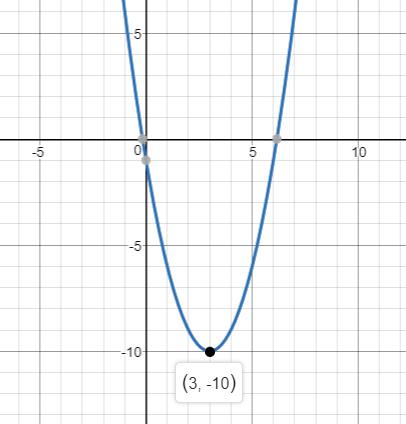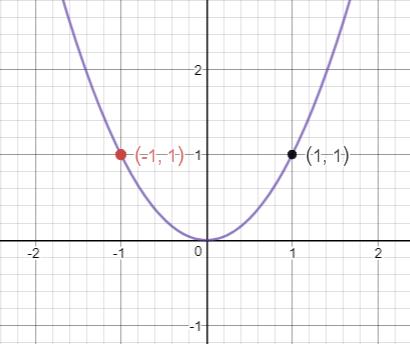
Concept explainers
In Problems 21-32, graph the function by starting with the graph of and using transformations (shifting, compressing, stretching, and/or reflection). Verify your results using a graphing utility.
[ Hint: If necessary, write in the form .]
To graph: The transformation of the function .
Answer to Problem 24AYU

Explanation of Solution
Given:
We have to graph the function .
Graph:
The graph of the given function is

Interpretation:
The graph of is

Now, we can graph the given function by transforming the above graph.
The given function is .
The general form of a quadratic function is .
Here, if , the graph opens upward otherwise the graph opens downwards.
If is closer to 0, then the graph is shorter and wider.
If is large, then the graph is tall and narrow.
Then, the graph of is the graph of with units shifted horizontally and units shifted vertically.
Here, we can convert the given equation into the standard form by using the square completion technique.
Therefore, let us now add and subtract the square of half of the in the given equation.
Therefore, we get
Thus, the given equation can be written in the standard form as .
Since, is positive, the graph opens upwards.
In the given function, we have and , therefore, the graph is the graph of with 3 units shifted horizontally right and 10 units shifted vertically downwards.
Chapter 3 Solutions
Precalculus
Additional Math Textbook Solutions
A First Course in Probability (10th Edition)
College Algebra (7th Edition)
Introductory Statistics
Thinking Mathematically (6th Edition)
University Calculus: Early Transcendentals (4th Edition)
Elementary Statistics: Picturing the World (7th Edition)
- L ined sove in peaper Anoting PU+965 4 Which of the following is converge, and which diverge? Give reasons for your answers with details. When your answer then determine the convergence sum if possible. +1Σm=1 00 sin Sn Lake 55 Which of the following is converge, and which diverge? Give reasons for your answers with details. When your answer then determine the convergence sum if possible. 5700 2n=2√2+n Carrow_forwardMinistry of Higher Education & Scientific Research Babylon University College of Engineering- musayab Homobile Department Subject :Numerical Analyses Stage: Third Time: 90 min Date: 25-4-2023 2nd month exam/2nd semester (2022-2023) Note: Answer all questions, all questions have same degree. Q1:Given the values X 5 7 11 13 17 F(x) 150 392 1452 2366 5202 Evaluate f(9),using Newton's divided difference formula Q2:A slider in a machine moves along a fixed straight rod.its distance (x cm) along the rod is given below for various values of the time.Find the velocity and acceleration of the slider when t=0.3 seconds. t(seconds) 0 X (cm) 30.13 0.1 31.62 0.2 0.3 0.4 0.5 0.6 32.87 33.64 33.95 33.81 33.24 Q3:From the following table,find the area bounded by the curve and x- axis,between the ordinates x=7.74 to x=7.52 using Simpson's 1/3 rule. X y=f(x) 7.47 7.48 1.93 1.95 7.49 1.98 7.50 7.51 7.52 2.01 2.03 2.06 Q4:Given y+x with initial condition y=1 at x=0;find (y) for x=0.1 by Euler's method.…arrow_forwardV ined sove in peaper Pu+96er Which of the following is converge, and which diverge? Give reasons for your answers with details. When your answer then determine the convergence sum if possible. 21/11 55 a Which of the following is converge, and which diverge? Give reasons for your answers with details. When your answer then determine the convergence sum if possible. 1Σn=1 (2-") n° 3" 6"arrow_forward
- L ined sove in peaper Anoting PU+965 4 Which of the following is converge, and which diverge? Give reasons for your answers with details. When your answer then determine the convergence sum if possible. +1Σm=1 00 sin Sn Lake 55 Which of the following is converge, and which diverge? Give reasons for your answers with details. When your answer then determine the convergence sum if possible. 5700 2n=2√2+n Carrow_forwarda い पीर ined sove in peaper Pu+9625 Which of the following is converge, and which diverge? Give reasons for your answers with details. When your answer then determine the convergence sum if possible. 3" 6" 1Σn=1 (2-") n Lake = Which of the following is converge, and which diverge? Give reasons for your answers with details. When your answer then determine the convergence sum 1/n 2" (n-√n -n 2n-1 0 T=1 . if possible.arrow_forwardAnot ined sove in peaper +9198 PU+965 Q3// Draw and Evaluate fƒ³½³¸ x/3 x -dydx x²+y2 Lake Gart Draw and Find the centroid of the region between the parabola x + y² - 4y=0 and the 2x+y=0 in the xy-plane 3+arrow_forward
- : +0 العنوان I need a detailed drawing with explanation しじ ined sove in peaper Anoting Q4// Draw and Evaluate √√√xy-²sin(y²)dydx PU+96er Lake Ge Q3// Find the volume of the region between the cylinder 2 = y² and the xy- plane that is bounded by the planes x = 1, x = 2, y = -2, and y = 2. T Marrow_forwardUniversity of Babylon Faculty of Engineering-AIMusyab Automobile Eng. Dep. Year: 2022-2023, 2 Course, 1 Attempt Note: Answer five questions only. Stage Third Subject: Numerical Analysis Date: 2023\\ Time: 3 Hour Q1: Solve the poisson equation [Uxx + Uyy = -81xy), [arrow_forwardMinistry of Higher Education & Scientific Research Babylon University College of Engineering- Al musayab Subject :Numerical Analysis Stage:Third Time: 2 hour Automobile Department Date:26-3-2023 nd 1st month exam/2" semester (2022-2023) Note: Answer all questions, all questions have same degree. Q1: Use Newton's method to find solutions to the system with two step Take (X,Yo)=(8,10). { x35x2 + 2xy + 13 = 0 x3 + x²-14x-y-19=0 Q2/:Solve the system by Gauss-Seidel iterative method.(Perform only three iterations). 8x-3y+2z-20 4x+11y-z-33 6x+3y+12z-35 03/:Curve fit the data using a power function X 2 4 8 5 6 0.7500 0.1875 0.1200 0.0833 0.0469arrow_forwardUniversity of Babylon Faculty of Engineering-AlMusyab Automobile Eng. Dep. Year: 2022-2023, 2nd Course, 1 Attempt Stage: Third Subject: Numerical Analysis Date: 2023\\ Time: 3 Hour dy = x + yl Q5-A: Using Euler's method, find an approximate value of (y) corresponding to (x=0.3),given that[- and [y=1 when x=0].(taking h=0.1). dx (10 M) Q5-B Find a root of an equation[f(x)=x-x-1] using Newton Raphson method to an accuracy of &=0. (10 M) Q6:Using Newton's divided differences formula, evaluate f(8) given: X 4 58 7 103 11 13 Y=f(x) 48 100 900 294 1210 2028 (20 M) Lexaminer: Examiner: Good luck W Head of Department:arrow_forwardExplain the conditions under which the Radius of Convergence of the Power Series is a "finite positive real number" r>0arrow_forwardThis means that when the Radius of Convergence of the Power Series is a "finite positive real number" r>0, then every point x of the Power Series on (-r, r) will absolutely converge (x ∈ (-r, r)). Moreover, every point x on the Power Series (-∞, -r)U(r, +∞) will diverge (|x| >r). Please explain it.arrow_forwardarrow_back_iosSEE MORE QUESTIONSarrow_forward_ios
 Calculus: Early TranscendentalsCalculusISBN:9781285741550Author:James StewartPublisher:Cengage Learning
Calculus: Early TranscendentalsCalculusISBN:9781285741550Author:James StewartPublisher:Cengage Learning Thomas' Calculus (14th Edition)CalculusISBN:9780134438986Author:Joel R. Hass, Christopher E. Heil, Maurice D. WeirPublisher:PEARSON
Thomas' Calculus (14th Edition)CalculusISBN:9780134438986Author:Joel R. Hass, Christopher E. Heil, Maurice D. WeirPublisher:PEARSON Calculus: Early Transcendentals (3rd Edition)CalculusISBN:9780134763644Author:William L. Briggs, Lyle Cochran, Bernard Gillett, Eric SchulzPublisher:PEARSON
Calculus: Early Transcendentals (3rd Edition)CalculusISBN:9780134763644Author:William L. Briggs, Lyle Cochran, Bernard Gillett, Eric SchulzPublisher:PEARSON Calculus: Early TranscendentalsCalculusISBN:9781319050740Author:Jon Rogawski, Colin Adams, Robert FranzosaPublisher:W. H. Freeman
Calculus: Early TranscendentalsCalculusISBN:9781319050740Author:Jon Rogawski, Colin Adams, Robert FranzosaPublisher:W. H. Freeman
 Calculus: Early Transcendental FunctionsCalculusISBN:9781337552516Author:Ron Larson, Bruce H. EdwardsPublisher:Cengage Learning
Calculus: Early Transcendental FunctionsCalculusISBN:9781337552516Author:Ron Larson, Bruce H. EdwardsPublisher:Cengage Learning





